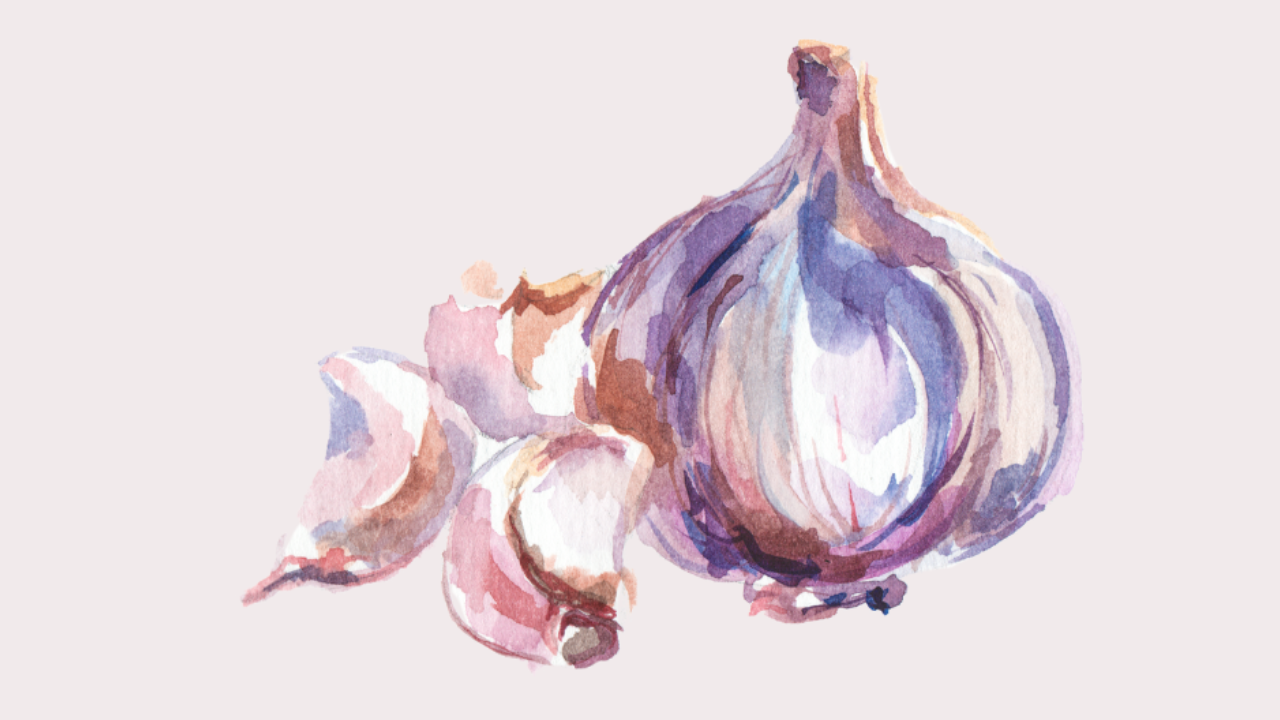The Health Benefits of Garlic in Menopause

Garlic not only gives flavour to our food but also medicinal value to our meals. It is an easy and tasting addition to your plate that has a myriad of health benefits.
Medicinally garlic is called Allium sativum, but it has a long list of common names including stinky rose, camphor of the poor, the nectar of the gods, and Russian penicillin - linking its common name to its believed native origins in Siberia but also to its anti-bacterial qualities.
Garlic is a member of the allium family, which also included onions, leeks, shallots, and chives. Garlic is believed to contain the greatest amount of medicinal components from within the allium family. The word garlic is derived from an old English word meaning spear-shaped leek.
Hippocrates is famous for saying “Let food be thy medicine and medicine be thy food”.
Garlic is a perfect example of this. Humans have been using garlic medicinally for over 5000 years. The ancient Babylonians, Romans, Greek, Egyptians, Russians, and Chinese all have a long documented history of use. A lot of their uses have been validated with science and we will discuss these shortly but others such as warding off evil spirits and repelling vampires, I’m not so sure about.
Let’s start by looking at the health benefits for the peri-menopausal woman.
For those of us who are still cycling garlic may help reduce reproductive pain and inflammation.
A 2021 study titled “The effect of garlic tablets on endometriosis-related pains”, found that taking 400 mg garlic tablet daily reduced uterine, pelvic, and back pain by 72% while the control group experienced an increase in pain over the same time frame.
Another 2021 study called “Effect of Garlic Supplementation on premenstrual disorders” This investigation looked at the effects of garlic supplementation for women with moderate to severe PMS. These women also took 400mg of garlic daily. They were reassessed after 3 cycles and 91% of the treatment group had their diagnosis downgraded to only mild PMS.
Garlic contains phytoestrogens in the forms of lignans (secoisolariciresinol and matairesionol) and isoflavones (daidzein and genistein). Unfortunately, in my literature search, I didn’t find any sources specifically looking at garlic and hot flushes, but I did find literature looking at the specific phytoestrogens found in garlic, reducing hot flushes.
As we transition into menopause, the reduction of our estrogen levels results in lower cardiovascular protection and increases our risk of cardiovascular events. Many women are concerned about their heart health at this time of life and garlic can be a wonderful preventative strategy to start now to minimise our risks and protect both our heart and arteries moving forward. Specifically, garlic helps to regulate our blood pressure, improve our blood lipid profile and help maintain healthy arteries.
Another serious consideration for postmenopausal women is osteoporosis. Garlic may help reduce bone loss and with its anti-inflammatory effects, it may also help reduce joint pain.
With the reduction of estrogen, also comes an increased risk of blood sugar issues. If you have diabetes or metabolic syndrome, garlic may be helpful. One study found that when garlic was paired with metformin, a standard blood sugar-lowering medication, the results improved. The garlic and metformin combination had a 70% improvement in results compared to metformin alone. Keep this in mind when we chat about medical interactions later on.
Liver health is also impacted by menopause. Garlic may help to lower liver enzymes, especially AST and ALT these enzymes are commonly associated with the development and severity of fatty liver.
Garlic has immune-boosting, anti-bacterial, and anti-viral qualities. It has been long used as an immune booster and infection prevention. One study looking at daily garlic use over winter found a 63% reduction in self-reported infections and a shorter duration for those who still became unwell. Garlic also has anti-allergy qualities. It pairs quite nicely with horseradish to help minimise allergic rhinitis.
Garlic contains dietary fiber to help keep your bowels regular and prebiotics. Prebiotics act as a fuel source for your probiotics and help to maintain the health of your digestive microbiota.
If you would like to try garlic as a functional food, ideally you need 2 cloves daily. Raw garlic contains a protein called alliin and a heat-sensitive enzyme called alliinase. When you chew, crush, or slice raw garlic, the protein, and enzyme come together to form allicin. But what happens if you want to cook the garlic, considering alliinase the enzyme is destroyed when it touches the heat?
This is where the 10-minute garlic rule comes into play. Simply crush or slice your garlic, and leave it for 10 minutes to allow time for the protein and the enzyme to come together and form allicin, the active constituent, as this has a greater heat resistance and is safer to cook with.
If you are interested in trying garlic as a supplement remember that all supplements come with cautions, contra-indications and medical interactions and garlic is no exception. Obviously don’t take garlic if you have a garlic allergy or sulphur intolerance. The biggest medical interactions with garlic are due Ito its ability to improve the effectiveness of certain medications. The big 3 interactions are with blood pressure, blood glucose, and blood thinning medications. Make sure you ask your healthcare provider if it's safe for you to start taking a garlic product, as they may need to monitor you more often and potentially reduce the dose of your medication.
References
https://pubmed.ncbi.nlm.nih.gov/34335819/
https://pubmed.ncbi.nlm.nih.gov/34760020/
https://pubmed.ncbi.nlm.nih.gov/23039014/


